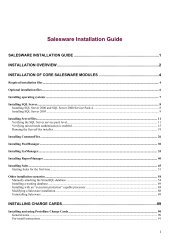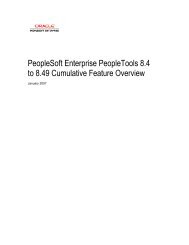Cognos ReportNetTM Installation and Configuration Guide
Cognos ReportNetTM Installation and Configuration Guide
Cognos ReportNetTM Installation and Configuration Guide
You also want an ePaper? Increase the reach of your titles
YUMPU automatically turns print PDFs into web optimized ePapers that Google loves.
Chapter 6: Configuring Framework Manager<br />
Steps<br />
1. Start <strong>Cognos</strong> <strong>Configuration</strong>.<br />
2. In the Explorer window click the appropriate group or component:<br />
• To change the port number for the dispatcher, click Environment.<br />
• To change the port number for the local log server, under Environment, click Logging.<br />
3. In the Properties window, click the Value box next to the property that you want to change.<br />
4. If you change the dispatcher port, ensure that you change the ports in other URIs that<br />
contain localhost.<br />
5. From the File menu, click Save.<br />
Configure SSL Protocol<br />
You can configure ReportNet components to use the Secure Sockets Layer (SSL) protocol for<br />
• internal connections only<br />
• external connections only<br />
• internal <strong>and</strong> external connections<br />
• connections to local <strong>and</strong> remote log servers.<br />
If you configure SSL only for internal connections, ReportNet components on the local computer<br />
communicate using this protocol. The dispatcher listens for secure connections on a different<br />
port than for remote, http requests. Therefore, you must configure two dispatcher URIs.<br />
If you configure SSL only for external connections, communications from remote ReportNet<br />
components to the local computer use the SSL protocol. You must configure the dispatcher to<br />
listen for secure, remote requests on a different port than local, http requests.<br />
If you configure SSL for all connections, the dispatcher can use the same port for internal <strong>and</strong><br />
external connections. Similarly, if you do not use SSL for local or remote communication, the<br />
dispatcher can use the same port for all communications.<br />
You must also update the Content Manager URI, SDK URI, <strong>and</strong> Gateway URI to use SSL, if<br />
required.<br />
Tomcat Connectors<br />
When the internal <strong>and</strong> external dispatcher URIs are the same, only one HTTP/1.1 connector is<br />
required in Tomcat’s configuration file, the server.xml file, located in the<br />
crn_location/tomcat4.1.18/conf directory. The port number in the dispatcher URIs is used to<br />
update the port number in the appropriate non-SSL Coyote HTTP/1.1 or SSL Coyote HTTP/1.1<br />
connector.<br />
If the internal dispatcher URI is prefixed with http but the external dispatcher URI is prefixed with<br />
https, or vice versa, both the non-SSL Coyote HTTP/1.1 <strong>and</strong> SSL Coyote HTTP/1.1 connectors<br />
are enabled in the server.xml file.<br />
Distributed <strong>Installation</strong>s<br />
In distributed installations, if you are using the ReportNet certificate authority service, you must<br />
first configure all ReportNet computers to use the non-secure (http) protocol before you<br />
configure ReportNet to use the SSL protocol. You must do this because you cannot set up the<br />
SSL protocol before trust has been established.<br />
Also, ensure that you follow the required order of configuring computers in a distributed<br />
environment. That means that you must first configure the computer where Content Manager is<br />
installed <strong>and</strong> then start the services on this computer before you configure other computers or<br />
start services on other computers. By first configuring the Content Manager computer <strong>and</strong><br />
starting the services, you ensure that the certificate authority service on the Content Manager<br />
computer can issue certificates to other computers in the ReportNet environment.<br />
After you configure all computers in the distributed installation to use the default, non-secure<br />
protocol, we recommend that you test your installation to ensure that ReportNet is working<br />
properly. After you test your installation, you can configure the SSL protocol.<br />
<strong>Installation</strong> <strong>and</strong> <strong>Configuration</strong> <strong>Guide</strong> 69
















